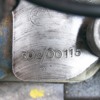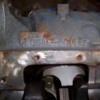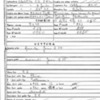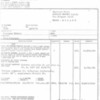Well hope some of this helps, this is what I know about these parts for original production, not over the counter replacement parts.
This is just what I know, but I'm not the expert to go to. This is just from documentation that is fairly well known or accepted in other circles which may or may not overlap here, and could be incorrect but is pretty well excepted as correct by the judging bodies. I'm not going to be the defense lawyer to defend these statements in court as gospel and that is not the intent of them as far as I am concerned.

In Ford parts, there are two different animals your are talking about. Production and replacement. Replacement parts are rarely the same as original production. Even when it is a Ford Service part.
Back then, that didn't matter much to anyone because no one thought 40 years down the road as far as value or desirability and having the original production part or a replacement part would effect the value of the car.
In the Mustang "Concourse" events, it is the original production line part that is the correct part. It doesn't matter if you have the Ford Service Part on your car that you bought from Ford Service Parts. It is still wrong for Concourse.
Other clubs tend to follow along the same lines as far as making judgments but also other manufacturers such as GM didn't operate the same as Ford did with a difference between production line parts and "genuine replacement service parts" being often different.
Accobra is positively correct in that it is the "original production" part that is now the most valuable and often what people are asking about in what is the "correct" part. This is really hitting home on cars that are drastically escalating recently in value like the Mangusta is.
The C90F-R is a "Service Part". It does not require a special intake manifold. "Use it as you like". It is not a '67 or '68 Shelby GT350 carb.
The '67 Shelby GT350 carb is stamped S7MS. There are two '68 Shelby GT350 carbs. S8MS-9510-A or C. They were only used in production after May 15, 1968, and only on the S7MS COBRA lettered intake which also was not installed in production until after 5/15/68.
There was a service recall campaign to change the intake manifolds from the cast iron to the aluminum COBRA, but that did not include the Holley Shelby carb.
The C80E 302 block is the '68 "J" code 4v engine block. It is only used in '68 production. Any model line that would have used the J code would have had that block.
Yes the 68 GT350 used the J code engine but it is not unique to the Shelby at all.
There is also a C8AE block that shows up occasionally but I think is the exception rather than the rule. They both look the same to me except for the casting numbers.
The C8FE block is both the '68 Tunnelport 302 and the '69 Boss 302 production block. It is a 4 bolt block. The Boss casting is actually C8FE-B. Perhaps the T/A block is the -A?
http://www.boss302.com/block.htmAs far as I know these Boss blocks are the last of the special production Ford 4 bolt small blocks.
The first one that I am aware of is the C6FE. The last one the C8FE.
The C6FE was taken out of the Ford "Indy" racing program. It is referred to as the "GT40" block but that is not entirely true. It came out the special race program and was applied to the GT40's.
The same is true of the C6FE 289 heads. They are referred to as "heavy duty" heads in the Ford engineering "notes" and there are several versions of them.
They were used more in the '67 Shelby coupe Trans-Am cars then anything else but you could have bought them from Shelby in their race car parts program ported or unported.
There are listings all over the place that are sometimes inaccurate or incomplete as far as applications.
These aren't necessarily an intentional misleading mislisting. It depends on what publication that writer was using for documentation.
The Ford Service Parts book is not always the most accurate as far as original application since it is really showing what was available as a service replacement part over the counter at that time.
It should also be noted that often the casting number is the "engineering number" and that does not always translate exactly into the part number or the service number.
It can get confusing on some of the parts really quickly.
Randy Gillis is a long time Shelby racer and has "connections" into the Ford Racing/Engineering program in southern California since 1966.
He has got copies of several of the foundry casting log books which actually show the original engineering designations and the revisions to them through the evolution of the parts.
These are actually a step before the "Engineering" logs since those only list the latest version of the original engineering number.
He pointed out to many, things like, the C8FE "trans-am" block has differences to it than the C8FE '69 Boss 302 block because of engineering revisions in the casting process.
In many cases most would never (me) would never notice the differences in the castings unless I had an example of each right in front of me at the same time.
Sometimes when you read a magazine article that might say something like "Ford gave several their aluminum 4 bolt Cleveland blocks to "Dyno Don Nicholson", and you found out that Nicholson sold them to someone else, a lot of the time that someone else was Gillis.
He had the benefit of personally knowing some of the "big" racers like Nicholson and some of the Ford development engineers because he raced with them.
That is a unique advantage that puts him into probably a group of only one that is left.
I'm just stating this because I don't want to be accused of attempting to be the expert here which I am not. I am just passing along information that was given to me by a "higher authority" so to speak, and I do the best to pass it along as best I can and try to avoid being burned at the stake by a mob carrying torches and yelling heresy at me.

This is as far as I will go. I will not venture an opinion on whether of not the "Flat Earth Society" is right or wrong. Some of them are my friends.






